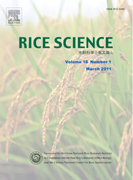|
|
Relationships of Panicle Type Index with Subspecies Characteristics and Yield Traits in Filial Generation of Crosses between Indica and Japonica Rice
XU Hai, ZHU Chun-jie, GUO Yan-hua, XU Quan, MAO Ting, CHEN Kai, WANG Jia-yu, YANG Li, ZHENG Jia-kui, XU Zheng-jin
2010, 17(2):
149-155 .
DOI: 10.1016/S1672-6308(08)60118-3
Two recombinant inbred line (RIL) populations, one derived from a cross between Zhongyouzao 8 (indica) and Toyonishiki (japonica) and the other from a cross between Qishanzhan (indica) and Akihikari (japonica), were grown in Liaoning and Sichuan Provinces, China, to study the panicle type index (PTI, the ratio of a number of node position on panicle axis where the secondary branch with the most numerous secondary branch grains is located to the number of primary branches) and its relationships with subspecies characteristics and yield traits. With continuous distribution of PTI and numerous of lines with different PTIs in the progenies, indica-japonica hybridization could be a method for breeding cultivars with ideal panicle type. PTI was significantly influenced by environments, with a significant decrease from Liaoning to Sichuan. A significantly negative correlation was found between PTI and most of subspecies characteristics. PTI varied remarkably with different subspecies types. As a whole, it showed a trend of indica (H)>indicalinous (H’)>japonicalinous (K’)>japonica (K). However, it is not appropriate to regard PTI as a parameter for subspecies classification in rice because it was recombined in the filial generations of cross between indica and japonica rice. The negative correlations were found between PTI and most of panicle characteristics, as well as yield-related traits. Based on PTI, most of lines from the two populations were middle dominant panicle type (the number of grains on the secondary branch is numerous in middle position of the panicle) and lower dominant panicle type (the number of grains on the secondary branch is numerous in lower position of the panicle and becomes less towards the top of panicle) with significant yield advantages.
|

